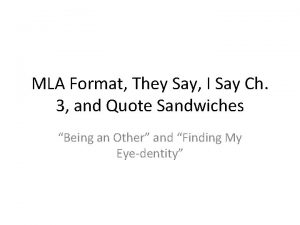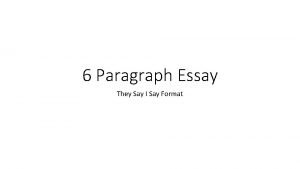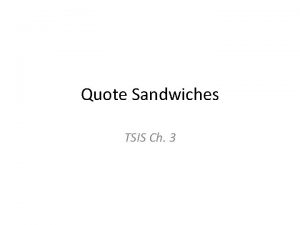They SayI Say Introduction Entering the Conversation Entering








- Slides: 8

They Say/I Say Introduction: Entering the Conversation

Entering the Conversation Think about any activity that you’re good at: playing piano, riding a horse, playing chess, cooking, or shooting a basketball. Once you’re good at this activity, you no longer have to give it much conscious thought, which means that in order to be a good basketball player, chef, or chess player, you’ve first had to master a series of smaller moves--moves that are no longer part of your conscious thoughts. The same principle is true about writing. In order to be a good writer, one must master a series of small-scale moves that they no longer devote conscious energy to.

Entering the Conversation One way to think about these moves, then is to consider them as templates to represent simple but crucial moves that are common to academic writing. Here are some examples: #1. ) “Many Americans assume that _______. ” #2. ) “On one hand, _______. On the other hand _______. ” #3. ) “Author X contradicts herself. At the same time that she argues _______, she also implies_______. ” #4. ) “I agree that ____. ” #5. ) “This is not to say that _____. ”

Entering the Conversation Effective academic writing ought to enter a conversation. Good writing should not only include the writer’s ideas-by including “Here is what I say…” But it should also include a response to what other writers have said about the topic by saying something to the effect of “This is what they say…”

Entering the Conversation In academic writing, it is very important to “involve yourself in conversation” by responding to other people’s idea’s about a text Remember the point of academic writing is to is prepare you for writing in the “real world. ” And in the “real world” we rarely if ever support arguments in isolation In fact, we often defend our opinions once someone else has challenged them For example: #1. ) “Why didn’t you like that movie? I thought it was excellent. ” #2. ) “You’re delusion along with all the other Eagles’ fans! You actually think they’ll win the Super Bowl? ” #3. ) “Yes, I do, in fact, think that chocolate water ice is the worst flavor. Do you have a problem with that? !”

Entering the Conversation Consider the following interaction: “My daughter, who goes to Stuyvesant High School only blocks away from the former World Trade Center, thinks we should fly the American flag out our window. Definitely not, I Say: The flag stands for jingoism and vengeance and war. She tells me I’m wrong--the flag means standing together and honoring the dead and saying no to terrorism. In a way, we’re both right. ” How does this interaction exemplify the concept of “entering a conversation”? Notice that the “they” you interact with in an argument doesn’t have to be a notable author; it can be a close friend or relative.

Entering a Conversation Models to use to respond to other’s ideas: #1. ) “She argues _______, and I agree because _____. ” #2. ) “Her argument that_______ is supported by new research showing that _______. ” #3. ) “He claims that ____, and I have mixed feelings about it. On the one hand, I agree that____. On the other hand, I still insist that ______. ”

Entering the Conversation • Open your books to page 14 and 15. • Let’s try exercise #1 and #2.














